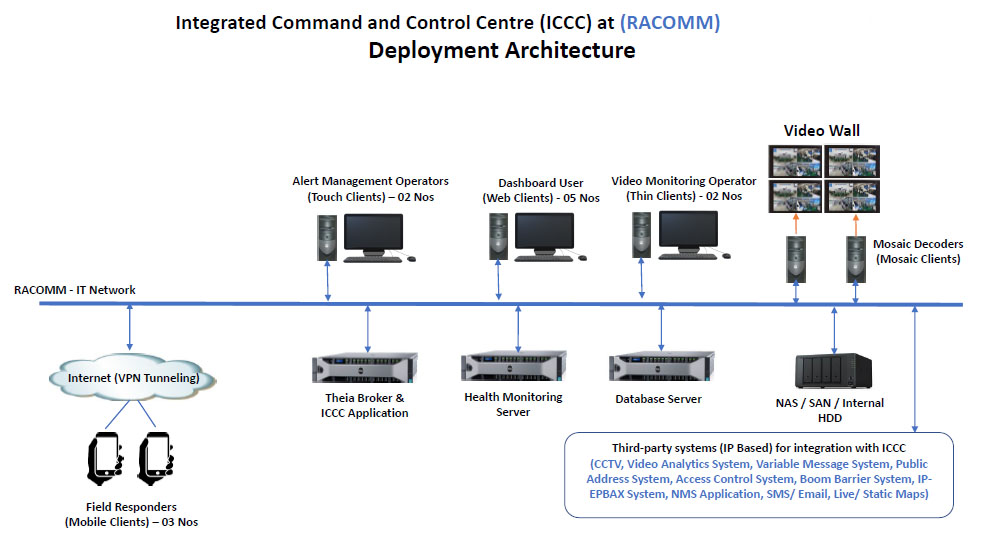
RACOMM SCADA (SANGAM) is a Windows-based application for monitoring and control of processes and systems in real-time. SANGAM software will be installed on the SCADA servers, and operator workstations (MMI) located at the operations control center (OCC) and backup control center (BCC). Data aggregation and storage is done in relational DBMS.
The T-SCADA system will interface with the telecommunication equipment / network management systems (NMS) being provided at the OCC, BCC, Depots, and Stations, for collection of status, alarms and events, so as to present a centralized system for monitoring the health and functioning of the telecom equipment. Racomm Telecom SCADA referred as SANGAM consists of Application software with backend data storage relational DBMS. SANGAM features
- Hardware Integration
- Archiving & Retention
- Real-time Monitoring
- Data Visualization
- HMI Integration
- Alarm Management
- Data Aggregation
- Dashboard Designer (IDE)
Telecom SCADA interface with sub systems in metro network
- Public Address System
- Public Information Display System
- Master Clock System
- Telephone System-EPABX
- Closed Circuit Television System;
- Fiber Optic Transmission System Giga Ethernet;
- Access Control and Intrusion Detection System;
- Centralized Voice Recording System
- Radio System
- UPS
- BMS
SYSTEM ARCHITECTURE
In the proposed T-SCADA system, the SCADA servers, operator workstations, and other SCADA equipment will be located at OCC and BCC. The SANGAM based SCADA server and operator workstations will be used for monitoring of the telecom equipment of metro.
The communications between the T-SCADA system at OCC/BCC and the telecom equipment / NMS at the stations, depots, etc. will be achieved using the FOTS network provided by the telecom contractor. Suitable interfacing equipment will be provided at each location to connect to the FOTS network.
One rack-mounted server grade machine will be provided for hosting SANGAM Application and Database server at each control center. These machines operate in hot-standby mode offering redundancy of the SCADA server functions.
Sangam Event Processor(SEP) and Sangam Alarm POOL(SAP) servers (one set at each control center) would be provided in redundant mode. These servers shall be centralized event database, and record all the alarms/events, and periodic status values. Reporting and historical trending functions will be driven from this database.
In addition to workstation machines (two at each OCC/BCC control center) will be installed for providing Man Machine Interface (MMI) functions to the operators.
SCADA SYSTEMS SPECIFICATIONS
The SCADA system installed at OCC/BCC will provide the following functions
- Communications with NMS / telecom equipment
- Pooling Events / Alarms
- Storing in Events/ Alarm in Database poll
- Alarm/Event handling thru SCADA MMI
- Calculations
- Reporting & Trending
- Backup / Restore
The two server machines will be configured in hot-standby configuration, with one server as the online server, and the other as hot-standby. Under normal circumstances, the online server updates the hot -standby on real-time basis.
The online server connects with the communication front-ends and requests activation of communication channels with the field equipment.
Two nos. workstation-grade computers each with dual-24 LED Monitor will be provided as operator (MMI) workstations. The MMI workstations installed at OCC provide the following functions
- Graphical display of a. Telecom equipment status
- Alarm/Event Lists
- Historical data, in trend chart form
- Communications system status
- Report generation
INTERFACE WITH TELECOM EQUIPMENTS
The T-SCADA will interface with NMS / telecom equipment over the FOTS or the Local Area Network thru SNMP / Ping / OPC protocol for status and alarm pooling. T-SCADA servers and workstations shall sync time with MCS for time syncing over NTP protocol.
SNO |
Telcom Sub
System |
Supported Protocol |
Event /
Alarm/control |
SEP & SAP-
PRIMARY |
SEP& SAP-
STADNBY |
Output |
01 |
FOTS |
SNMP/PING |
NMS |
Status |
|
|
- Audible Alarm
- Real time data view
Alarm / Events
Control / Action
Reporting
Trending
3rd party data access.
Charts and Graphs |
|
|
|
Alarm |
|
|
|
02 |
RADIO |
SNMP |
Radio |
Pooling and |
Real time synching |
|
|
|
Equipment Status/Alarms |
|
|
|
|
analysis of events and Alarms |
from Primary |
03 |
PAS |
SNMP/PING |
PAS Equipment Status/Alarms |
04 |
PIDS |
SNMP/PING |
PIDS Equipment |
|
|
|
|
|
Status/Alarms |
|
|
05 |
MCS |
NTP |
Date / Time |
|
|
|
|
|
GPS Sync. |
|
|
|
|
|
Status/Alarms |
|
|
06 |
ACS |
OPC/ SNMP |
Access Control |
|
|
|
|
|
Alarms/Events |
|
|
07 |
CCTV |
SNMP/PING |
CCTV |
|
|
|
|
|
Surveillance |
|
|
|
|
|
Alarms/Events |
|
|
08 |
CDRS |
SNMP |
CVRS Alarms / |
|
|
|
|
|
Status |
|
|
09 |
WI-FI |
SNMP |
NMS |
status |
|
|
|
|
|
Alarm |
|
|
|
10 |
UPS |
SNMP |
NMS |
status |
|
|
|
|
|
Alarm |
|
|
|
* More Interfaces can be added as per customer requirement.
NETWORKING
The proposed solution will interface with the fiber-optic telecommunications system for Ethernet-based communications between the field equipment and the T-SCADA system.
The communications between the OCC and BCC would take place using redundant Ethernet communication channels over the FOTS network.
At the control center, a dual redundant SCADA LAN would be established to operate in fault- tolerant mode. All SCADA computers connected to the SCADA LAN would have two Ethernet ports configured to operate in fault -tolerant mode.
TIME-SYNCHRONIZATION
For time-synchronization of the T-SCADA system, a Master clock system will be connected over the SCADA LAN. The SCADA system will synchronize itself with Master clock